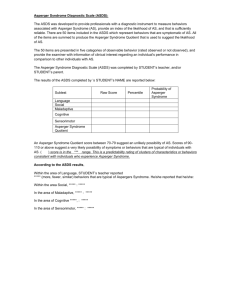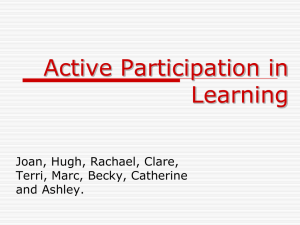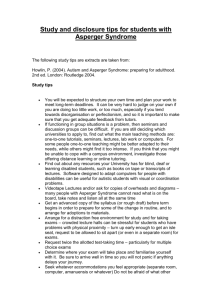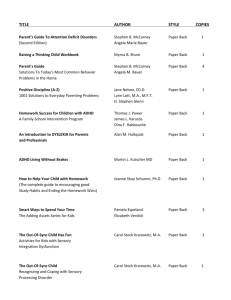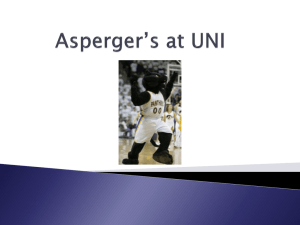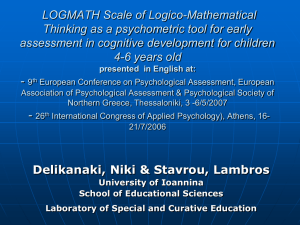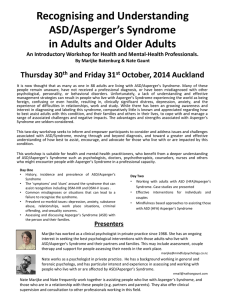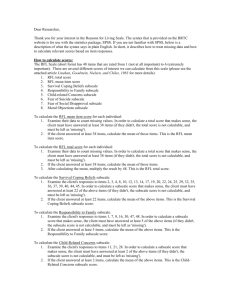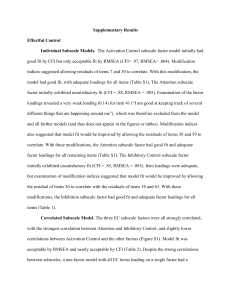Asperger Syndrome Diagnostic Scale (ASDS
advertisement
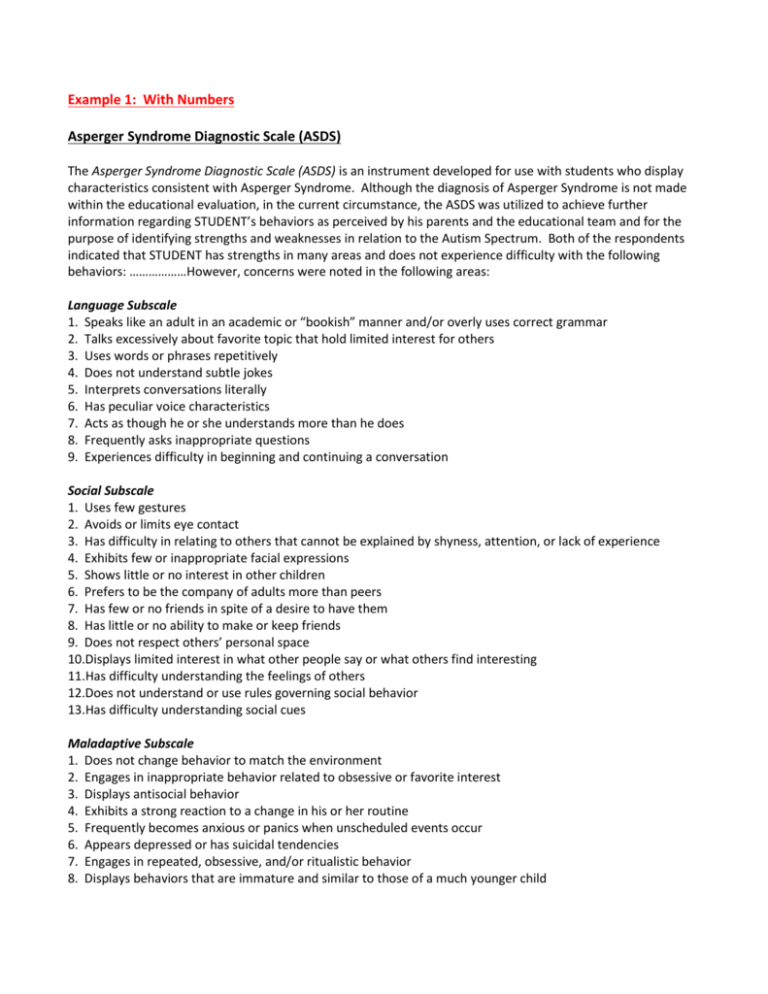
Example 1: With Numbers Asperger Syndrome Diagnostic Scale (ASDS) The Asperger Syndrome Diagnostic Scale (ASDS) is an instrument developed for use with students who display characteristics consistent with Asperger Syndrome. Although the diagnosis of Asperger Syndrome is not made within the educational evaluation, in the current circumstance, the ASDS was utilized to achieve further information regarding STUDENT’s behaviors as perceived by his parents and the educational team and for the purpose of identifying strengths and weaknesses in relation to the Autism Spectrum. Both of the respondents indicated that STUDENT has strengths in many areas and does not experience difficulty with the following behaviors: ………………However, concerns were noted in the following areas: Language Subscale 1. Speaks like an adult in an academic or “bookish” manner and/or overly uses correct grammar 2. Talks excessively about favorite topic that hold limited interest for others 3. Uses words or phrases repetitively 4. Does not understand subtle jokes 5. Interprets conversations literally 6. Has peculiar voice characteristics 7. Acts as though he or she understands more than he does 8. Frequently asks inappropriate questions 9. Experiences difficulty in beginning and continuing a conversation Social Subscale 1. Uses few gestures 2. Avoids or limits eye contact 3. Has difficulty in relating to others that cannot be explained by shyness, attention, or lack of experience 4. Exhibits few or inappropriate facial expressions 5. Shows little or no interest in other children 6. Prefers to be the company of adults more than peers 7. Has few or no friends in spite of a desire to have them 8. Has little or no ability to make or keep friends 9. Does not respect others’ personal space 10.Displays limited interest in what other people say or what others find interesting 11.Has difficulty understanding the feelings of others 12.Does not understand or use rules governing social behavior 13.Has difficulty understanding social cues Maladaptive Subscale 1. Does not change behavior to match the environment 2. Engages in inappropriate behavior related to obsessive or favorite interest 3. Displays antisocial behavior 4. Exhibits a strong reaction to a change in his or her routine 5. Frequently becomes anxious or panics when unscheduled events occur 6. Appears depressed or has suicidal tendencies 7. Engages in repeated, obsessive, and/or ritualistic behavior 8. Displays behaviors that are immature and similar to those of a much younger child 9. Frequently loses temper or has tantrums 10.Frequently feels overwhelmed or bewildered, especially in crowds or demanding situations 11.Attempts to impose narrow interests, routines, or structures on others Cognitive Subscale 1. Displays superior ability in restricted area of interest, while having average to above average skills in other areas 2. Displays an extreme or obsessive interest in a narrow subject 3. Functions best when engaged in familiar and repeated tasks 4. Has excellent rote memory 5. Learns best when pictures or written words are present 6. Has average to above average intelligence 7. Appears to be aware that he or she is different from others 8. Is oversensitive to criticism 9. Lacks organizational skills 10.Lacks common sense Sensorimotor Subscale 1. Displays an unusual reaction to loud, unpredictable noise 2. Frequently stiffens, flinches, or pulls away when hugged 3. Overreacts to smells that are hardly recognizable to those around him or her 4. Prefers to wear clothes made of only certain fabrics 5. Has a restricted diet consisting of the same foods cooked and presented in the same way 6. Exhibits difficulties with handwriting or other tasks that require fine motor skills 7. Appears clumsy or uncoordinated Example 2 – Without Numbers Asperger Syndrome Diagnostic Scale (ASDS) The Asperger Syndrome Diagnostic Scale (ASDS) is an instrument developed for use with students who display characteristics consistent with Asperger Syndrome. Although the diagnosis of Asperger Syndrome is not made within the educational evaluation, in the current circumstance, the ASDS was utilized to achieve further information regarding STUDENT’s behaviors as perceived by his parents and the educational team and for the purpose of identifying strengths and weaknesses in relation to the Autism Spectrum. Both of the respondents indicated that STUDENT has strengths in many areas and does not experience difficulty with the following behaviors: ………………However, concerns were noted in the following areas: Language Subscale Speaks like an adult in an academic or “bookish” manner and/or overly uses correct grammar Talks excessively about favorite topic that hold limited interest for others Uses words or phrases repetitively Does not understand subtle jokes Interprets conversations literally Has peculiar voice characteristics Acts as though he or she understands more than he does Frequently asks inappropriate questions Experiences difficulty in beginning and continuing a conversation Social Subscale Uses few gestures Avoids or limits eye contact Has difficulty in relating to others that cannot be explained by shyness, attention, or lack of experience Exhibits few or inappropriate facial expressions Shows little or no interest in other children Prefers to be the company of adults more than peers Has few or no friends in spite of a desire to have them Has little or no ability to make or keep friends Does not respect others’ personal space Displays limited interest in what other people say or what others find interesting Has difficulty understanding the feelings of others Does not understand or use rules governing social behavior Has difficulty understanding social cues Maladaptive Subscale Does not change behavior to match the environment Engages in inappropriate behavior related to obsessive or favorite interest Displays antisocial behavior Exhibits a strong reaction to a change in his or her routine Frequently becomes anxious or panics when unscheduled events occur Appears depressed or has suicidal tendencies Engages in repeated, obsessive, and/or ritualistic behavior Displays behaviors that are immature and similar to those of a much younger child Frequently loses temper or has tantrums Frequently feels overwhelmed or bewildered, especially in crowds or demanding situations Attempts to impose narrow interests, routines, or structures on others Cognitive Subscale Displays superior ability in restricted area of interest, while having average to above average skills in other areas Displays an extreme or obsessive interest in a narrow subject Functions best when engaged in familiar and repeated tasks Has excellent rote memory Learns best when pictures or written words are present Has average to above average intelligence Appears to be aware that he or she is different from others Is oversensitive to criticism Lacks organizational skills Lacks common sense Sensorimotor Subscale Displays an unusual reaction to loud, unpredictable noise Frequently stiffens, flinches, or pulls away when hugged Overreacts to smells that are hardly recognizable to those around him or her Prefers to wear clothes made of only certain fabrics Has a restricted diet consisting of the same foods cooked and presented in the same way Exhibits difficulties with handwriting or other tasks that require fine motor skills Appears clumsy or uncoordinated
